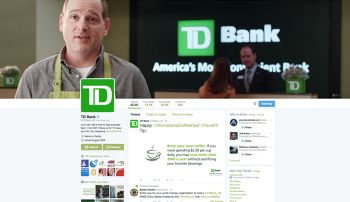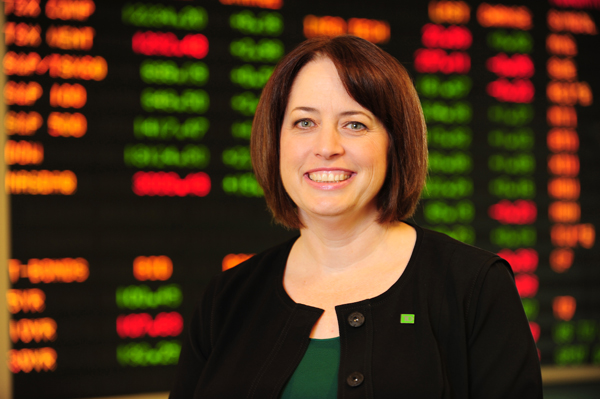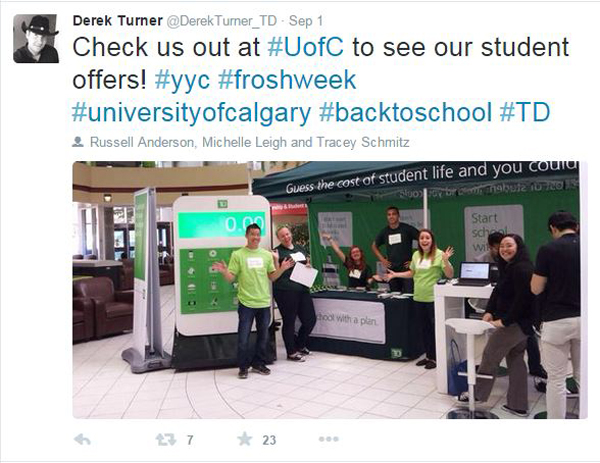Social media from the inside out
TD Bank’s internal social media efforts have impact beyond the bank’s walls
- |
- Written by Lisa Joyce
- |
- Comments: DISQUS_COMMENTS
 TD Bank’s public-facing social media presence, such as this Twitter home page, is just one side of its efforts. The bank also uses an internal social setup for internal purposes and to help employees hone their “social skills.”
TD Bank’s public-facing social media presence, such as this Twitter home page, is just one side of its efforts. The bank also uses an internal social setup for internal purposes and to help employees hone their “social skills.”
TD Bank was an early adopter of social media with the 2007 launch of a Facebook page for university students. Today, the bank shares information and engages with customers using a variety of social media platforms including LinkedIn, YouTube, Instagram, and Pinterest.
A measure of the bank’s investment in this platform can be made in terms of staffing: More than 70 customer service agents monitor and respond to customers via social media—7 days a week, 17 hours per day.
But there’s a layer to TD Bank’s social effort that many don’t think about.

About five years ago, the bank began using social media for internal communications as well, embedding a commenting engine and rating system in the company’s corporate news stories, explains Wendy Arnott, vice-president, Digital Marketing & Social Media, TD Bank Group.
“We wanted to give a voice to our employees and open up two-way conversation,” she adds.
The Connections platform
The two-way conversation proved a success, so in November 2011 TD Bank launched Connections, an enterprise collaboration platform made up of social tools such as profile pages, wikis, blogs, and discussion forums. As the name implies, Connections is used to connect employees across business segments and geographies as well as harness employee knowledge, build communities of interest, recognize and collaborate with fellow employees, and ultimately to deliver business value, says Arnott.
All employees of the bank have access to Connections and more than 60% of employees use the platform on a monthly basis for communications and collaborative working.
According to Arnott, employees use Connections for a variety of purposes:
• Posting ‘WOW Moments” status updates in which employees recognize each other for positive contributions.
• Sharing news articles, useful content, and encouraging messages.
• Participating in internal social campaigns.
• Personal development and building their own brand.
• Live chats, which Arnott describes as “our internal version of a Twitter chat.”
• As virtual workspaces that are especially useful for geographically dispersed teams.
External application
One of the main benefits of using social media internally is that employees build their social media fluency by gaining experience using the same tools they use externally to connect with customers.
“Employees are able to use internal social media to gain a fundamental understanding of how this technology can be leveraged, learn about best practices, and get comfortable with using social media prior to using it externally,” says Arnott.
For example, once they’ve completed a training course on social media best practices and compliance and regulatory considerations, branch banking employees can use social media to engage customers in discussions about financial topics such as home ownership and saving and investing as well as TD Bank’s community initiatives including children’s health, diversity, the environment, and financial literacy.

“More than 800 employees use social media to connect with their local community, establish themselves as experts, and build relationships with customers and prospects in a personalized and authentic way,” says Arnott. A small internal team supports these employees, helping them define their business purpose and sharing best practices for content and engagement.
Connections encourages knowledge sharing and collaboration, expedites finding of experts, and optimizes the employee online experience. However, the learning goes both ways. Employees learn how to use social media and the bank is able to apply what it learns from employees’ experience and usage to TD Bank’s external social media efforts.
“Externally we are using the same principles to ensure our employees understand how to leverage the tools they are using while being compliant. For example, we look to employee usage to learn how to gain engagement using appropriate content with visuals and calls to action, using best practices for hashtags, and how to optimize customer interactions on social media,” explains Arnott.
Arnott also notes that the bank can draw parallels between internal and external programs when it comes to finding the right balance of formal training for regulatory compliance purposes and informal adoption support.
In pursuit of social excellence
Employee adoption of social media served as the impetus for TD Bank’s Genius Community social media center of excellence that reaches the bank’s 85,000 employees. Arnott describes the Genius Community as a self-service support hub containing resources such as training materials and guides, case studies, wizards, and templates.
“We host weekly interactive calls that spotlight advanced users who share their successes. The team also offer consultations to support teams on their Connections journey,” explains Arnott.
Management is encouraged by how social media is transforming working practices at TD Bank. Although she declined to provide specific plans for expanding the bank’s internal social media initiatives, Arnott reiterated the bank’s continued commitment to using social media, both internally and externally.
“TD Bank values transparency in communication,” says Arnott, “and embedding social collaboration tools into the way we operate is critical for the way ahead.”
Tagged under Retail Banking, Blogs, Social Media, Channels, Feature, Feature3,















